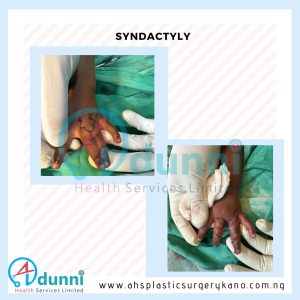
What is it?
Syndactyly is a congenital condition characterized by the fusion of two or more fingers or toes. It occurs when the skin with or without the bones of the digits fail to separate properly during fetal development. Syndactyly can occur in isolation, where it is not associated with other medical conditions, or as part of a syndrome, where it is one of several features present.
What are the types?
Syndactyly can affect different parts of the hand or foot, and the degree of fusion can vary from partial to complete. In partial syndactyly, the fusion does not reach the fingertips , while in complete syndactyly, the whole fingers are fused.
Syndactyly can also be classified based on the involvement of bone in the fusion, if the bones are involved, it is complex and if there is no bony involvement, it is called simple syndactyly.
How common is it?
Syndactyly is a relatively rare condition, affecting approximately 1 in 2,000 to 3,000 live births. It can occur in isolation or as part of a syndrome, with different types of syndactyly having varying levels of prevalence. For example, complete syndactyly of the hands is more common in males, while complete syndactyly of the feet is more common in females. Additionally, certain syndromes, such as Apert syndrome and Poland syndrome, are associated with a higher incidence of syndactyly. Overall, the prevalence of syndactyly varies depending on the location and severity of the fusion, as well as other factors such as genetic and environmental influences.
How is it treated?
Treatment for syndactyly typically involves surgery to separate the fused digits and reconstruct the soft tissue and bone structure of the affected area. The goal of surgery is to create functional, aesthetic fingers or toes that allow for normal hand or foot function. The surgery is usually performed when the child is between 6 and 12 months old, although the timing may vary depending on the individual case.
The surgical procedure for syndactyly can be complex and may involve multiple stages, especially in cases of complete fusion or when the digits are affected by other abnormalities.
What are the post-surgical care?
After the surgery, the child may require physical therapy to improve mobility and strength of the affected digits. Regular follow-up appointments with the surgeon are also necessary to monitor healing and to address any complications that may arise.
In some cases, orthotic devices, such as splints or braces, may be recommended after surgery to maintain alignment and promote proper healing. Additionally, genetic counseling may be recommended to assess the risk of recurrence of syndactyly in future pregnancies.
Are there associated risks?
Like any surgery, there are risks associated with the treatment of syndactyly. Some potential risks include:
- Infection: Surgery can introduce bacteria into the body, which may cause an infection. Antibiotics are usually given before and after surgery to prevent infection, but in some cases, additional treatment may be needed.
- Bleeding: Surgery can cause bleeding, which may require further treatment or blood transfusions in rare cases.
- Scarring: Surgery can leave scars, which may be noticeable and affect the appearance of the affected area.
- Nerve damage: Surgery can damage nerves in the affected area, which may result in numbness, weakness, or pain.
- Stiffness or reduced range of motion: After surgery, there may be stiffness or reduced range of motion in the affected fingers or toes, which may require additional physical therapy or orthotic devices.
- Recurrence: In some cases, syndactyly may recur after surgery, although this is rare.
It is important to discuss the potential risks and benefits of surgery with a qualified plastic surgeon and to carefully consider all treatment options before making a decision.
What are the benefits of treatment?
The benefits of treatment for syndactyly can be significant and include:
- Improved hand or foot function: Separating the fused digits can improve the range of motion and function of the affected hand or foot.
- Enhanced aesthetics: Reconstructive surgery can improve the appearance of the affected area, which may improve the child’s self-esteem and quality of life.
- Prevention of further complications: In severe cases of syndactyly, leaving the digits fused can lead to additional complications such as difficulties with grasping or walking, which may be prevented or reduced through surgical intervention.
- Improved social and psychological well-being: Treatment of syndactyly can improve the child’s ability to participate in social activities and interact with peers, leading to improved psychological well-being.
- Prevention of long-term physical and occupational limitations: Addressing syndactyly early through surgery can prevent long-term physical and occupational limitations that may impact the child’s quality of life.
In summary, the benefits of treatment for syndactyly can improve hand or foot function, enhance aesthetics, prevent further complications, improve social and psychological well-being, and prevent long-term physical and occupational limitations.
